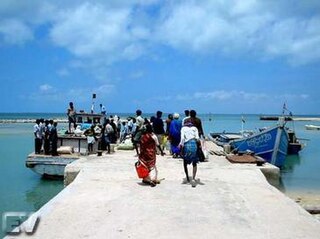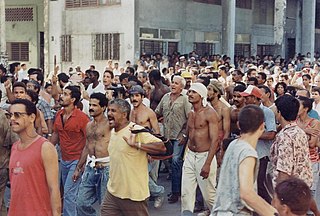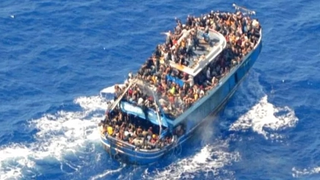
Goya was a Norwegian motor freighter used as a troop transport by Nazi Germany and sunk with a massive loss of life near the end of World War II.
SIEV X was the name assigned by Australian authorities to an Indonesian fishing boat carrying over 400 asylum seekers en route to Australia, which capsized in international waters with great loss of life on 19 October 2001. SIEV stands for Suspected Irregular Entry Vessel and is the acronym used by the surveillance authority for any boat that has entered Australian waters without prior authorisation. The X is a designation used where a tracking number has not yet been assigned, in accordance with Australian Government orders.

General Grant was a 1,005-ton three-masted bark built in Maine in the United States in 1864 and registered in Boston, Massachusetts. It was named after Ulysses S. Grant and owned by Messers Boyes, Richardson & Co. She had a timber hull with a length of 179.5 ft, beam of 34.5 ft and depth of 21.5 ft. While on her way from Melbourne to London, General Grant crashed into a cliff on the west coast of main island of the Auckland Islands of New Zealand, and subsequently sank as a result. Sixty-eight people drowned and only 15 people survived.

MV Le Joola was a Senegalese government-owned roll-on/roll-off ferry that capsized off the coast of The Gambia on 26 September 2002, with 1,863 deaths and 64 survivors. It is thought to be the second-worst peacetime disaster in maritime history.

A hell ship is a ship with extremely inhumane living conditions or with a reputation for cruelty among the crew. It now generally refers to the ships used by the Imperial Japanese Navy and Imperial Japanese Army to transport Allied prisoners of war (POWs) and rōmusha out of the Philippines, the Dutch East Indies, Hong Kong, and Singapore in World War II. These POWs were taken to the Japanese Islands, Formosa, Manchukuo, Korea, the Moluccas, Sumatra, Burma, or Siam to be used as forced labor.

German submarine U-48 was a Type VIIB U-boat of Nazi Germany's Kriegsmarine during World War II, and the most successful that was commissioned. During her two years of active service, U-48 sank 52 ships for a total of 306,874 GRT and 1,060 tons; she also damaged three more for a total of 20,480 GRT over twelve war patrols conducted during the opening stages of the Battle of the Atlantic.

The Jaffna lagoon massacre or Kilaly massacre occurred on January 2, 1993, when a Sri Lankan Navy Motor Gun Boat and a number of smaller speed boats intercepted a number of boats transporting people between the south and north shores of the Jaffna Lagoon in the Northern province in Sri Lanka, and attacked them under the glare of a spot light. The estimated number of deaths range from thirty five (35) to one hundred (100). However, only fourteen (14) bodies were recovered. It was reported that other victims of this massacre were burnt along with their boats. The Sri Lankan government claims that the boats were transporting rebel Liberation Tigers of Tamil Eelam (LTTE) cadres.

The Kumudini or Kumuthini boat massacre happened on 15 May 1985, when at least 23 minority Sri Lankan Tamil adults and children on a ferry boat named Kumudini sailing from the island of Delft to the island of Nainathivu were killed by Sri Lankan Navy personnel.

The Thrasher incident, as it became known in US media, was a political and diplomatic incident in 1915, when the United States was still neutral in World War I. On 28 March 1915 the German U-boat U-28 sank the British steamship Falaba by torpedo, killing more than 100 people. One of the victims was a passenger from the US, Leon Chester Thrasher.

SS Henry was a Norwegian steam-powered cargo ship best known for being one of the two ships sunk in one of the most controversial incidents in Norway during the Second World War.

The U-boat campaign from 1914 to 1918 was the World War I naval campaign fought by German U-boats against the trade routes of the Allies. It took place largely in the seas around the British Isles and in the Mediterranean. The German Empire relied on imports for food and domestic food production and the United Kingdom relied heavily on imports to feed its population, and both required raw materials to supply their war industry; the powers aimed, therefore, to blockade one another. The British had the Royal Navy which was superior in numbers and could operate on most of the world's oceans because of the British Empire, whereas the Imperial German Navy surface fleet was mainly restricted to the German Bight, and used commerce raiders and submarine warfare to operate elsewhere.

The Maleconazo was a protest on 5 August 1994, in which thousands of Cubans took to the streets around the Malecón in Havana to demand freedom and express frustration with the government. Following the collapse of the Soviet Union in the early 1990s, Cuba fell into a crippling economic crisis that had many citizens looking to flee the island. On the day of the protest, the Cuban police blocked people from boarding tugboats leaving Havana, prompting thousands of citizens to storm the streets in the largest anti-government demonstration Cuba had seen since the Cuban Revolution. In the following weeks, President Fidel Castro quelled the frustration by opening the doors of the country and allowing Cubans to leave, which had a significant impact on Cuba's relationship with the United States moving forward.

On 15 December 2010, an Indonesian fishing boat carrying 89 asylum seekers and 3 crew members sank after being dashed against the rocks near Rocky Point, Christmas Island, an external Australian territory. 50 people died and 42 were rescued. The incident was the worst civilian maritime disaster in Australia in more than a century.

Bulgaria was a class 785/OL800 Russian river cruise ship which operated in the Volga-Don basin. On 10 July 2011, Bulgaria sank in the Kuybyshev Reservoir of the Volga River near Syukeyevo, Kamsko-Ustyinsky District, Tatarstan, Russia, with 201 passengers and crew aboard when sailing from the town of Bolgar to the regional capital, Kazan. The catastrophe led to 122 confirmed deaths.
The Russian-flagged fishing trawler Dalniy Vostok sank on 1 April 2015, off Russia's Kamchatka Peninsula in the Sea of Okhotsk. Fifty-seven of the ship's 132 crew members were confirmed dead, with rescue operations underway for survivors. The freezer trawler sank 183 nautical miles west of Krutogorovsky, a settlement in Kamchatka's Sobolevsky District.

Cuban boat people mainly refers to refugees who flee Cuba by boat and ship to the United States.

On 14 June 2023, an Italy-bound fishing trawler smuggling migrants sank in international waters in the part of the Mediterranean known as the Ionian Sea, off the coast of Pylos, Messenia, Greece. The boat, named Adriana, which had a capacity of 400 people, carried an estimated 400 to 750 migrants, mostly from Pakistan, Syria, Palestine, and Egypt, and some from Afghanistan. After departing from Tobruk, Libya, on 10 June, concerns were raised by 13 June, with the vessel then located in the Maritime Search and Rescue (SAR) zone assigned to Greece. The Hellenic Coast Guard (HCG) helicopter and later the HCG vessel ΠΠΛΣ-920 arrived on scene, took aerial photos of the vessel, made offers of assistance that were allegedly refused, then remained there as an observer until the boat capsized and sank. After the Adriana had sunk "close to the deepest part of the Mediterranean Sea", the HCG and the military initiated a massive search and rescue operation. One hundred and four men were rescued, and 82 bodies were recovered. By 18 June, officials had acknowledged that over 500 people were "presumed dead."














